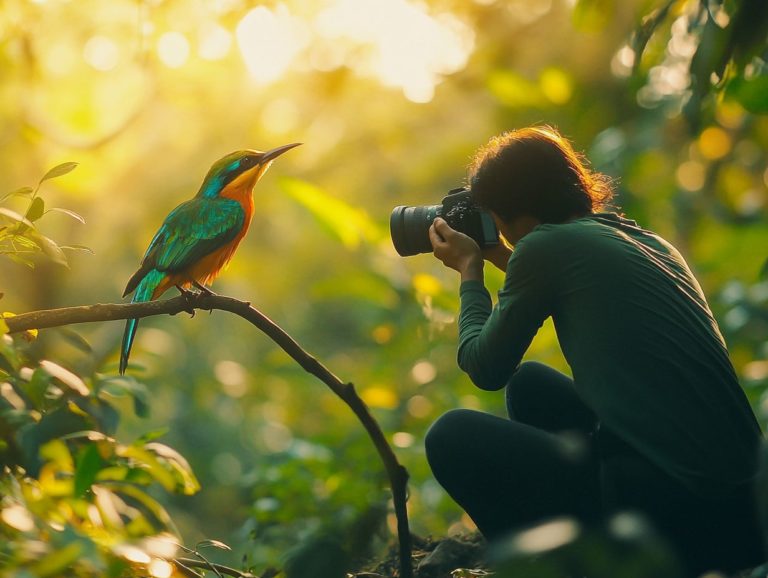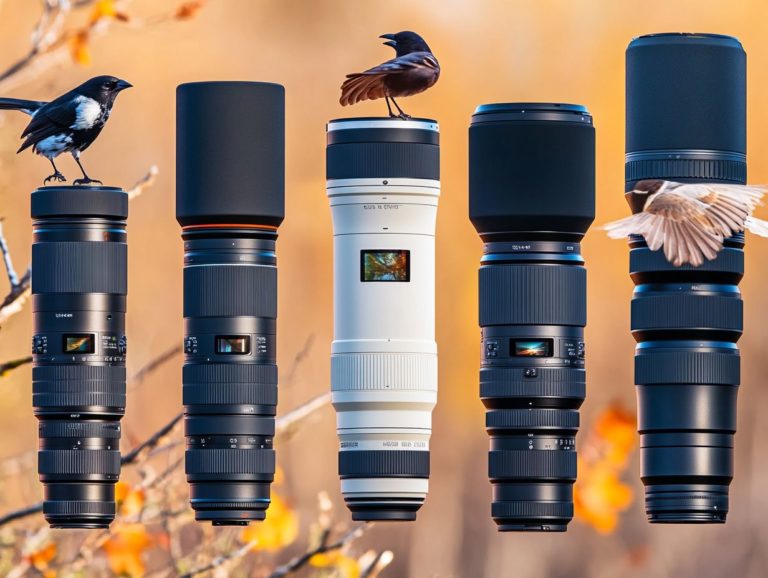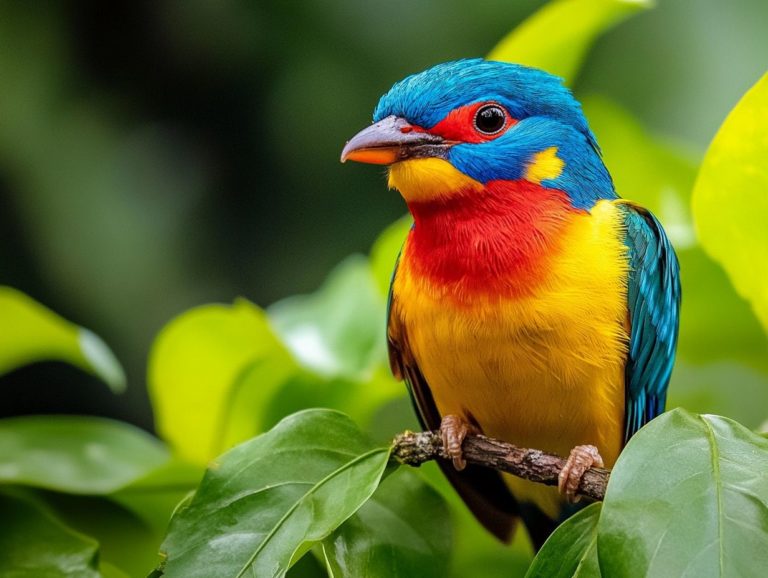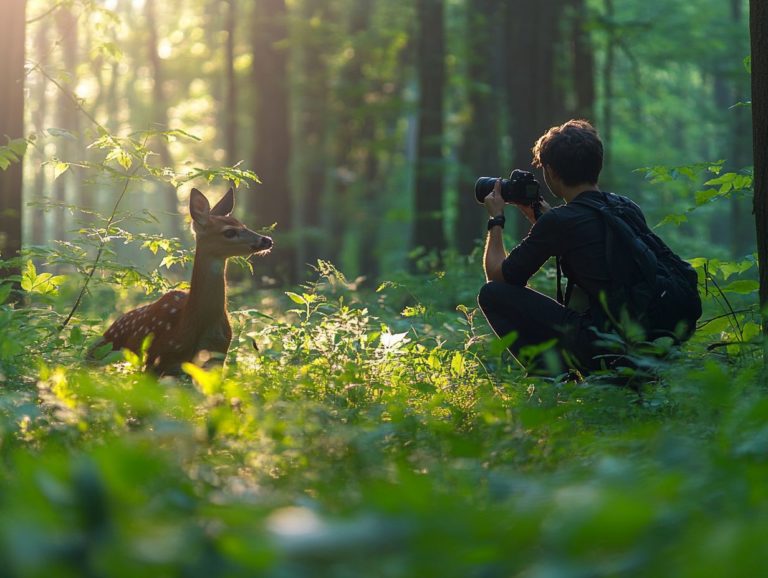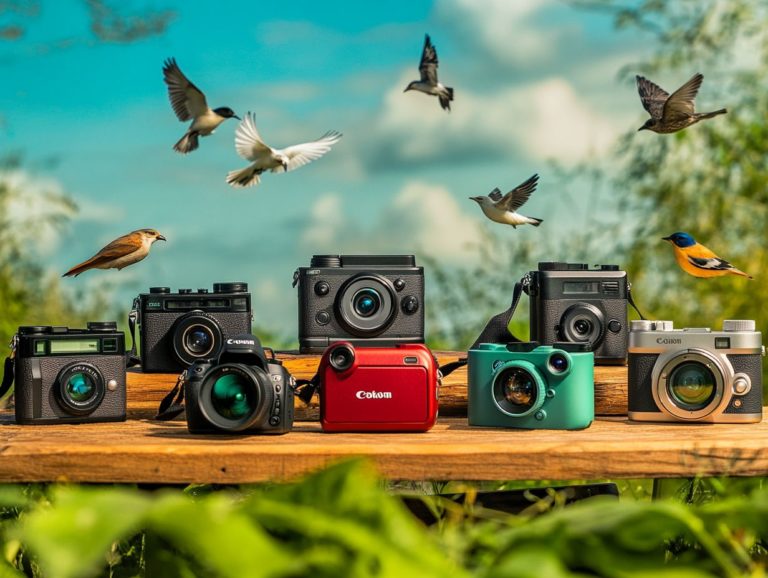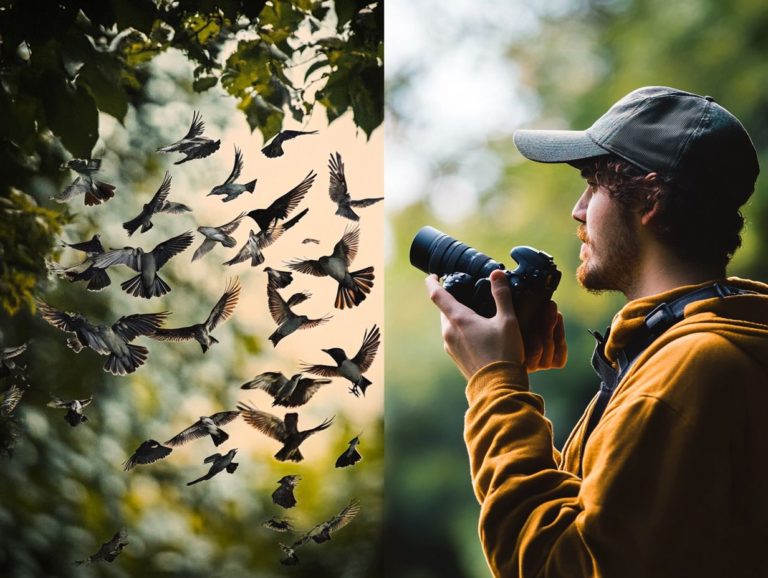Creating a Bird Photography Portfolio
Bird photography provides a remarkable glimpse into the beauty of nature, capturing those fleeting moments that reveal the grace and diversity of avian life.
Whether you re just starting out or you ve already honed your skills, crafting an impressive bird photography portfolio can elevate your creations and draw in an audience.
Let s dive in and explore how to select the perfect subjects, essential gear, and settings you’ll need, alongside effective composition and lighting techniques. You’ll also find tips for organizing and promoting your portfolio.
Prepare to explore how to showcase your passion for bird photography like never before!
Contents
- Key Takeaways:
- Choosing Your Subject Matter
- Equipment and Settings for Bird Photography
- Composition and Lighting Techniques
- Organizing and Curating Your Portfolio
- Promoting Your Bird Photography Portfolio
- Frequently Asked Questions
- What is a bird photography portfolio?
- Why should I create a bird photography portfolio?
- What are the key elements of a successful bird photography portfolio?
- How many images should I include in my bird photography portfolio?
- Do I need a website to showcase my bird photography portfolio?
- What are some tips for a visually appealing bird photography portfolio?
Key Takeaways:
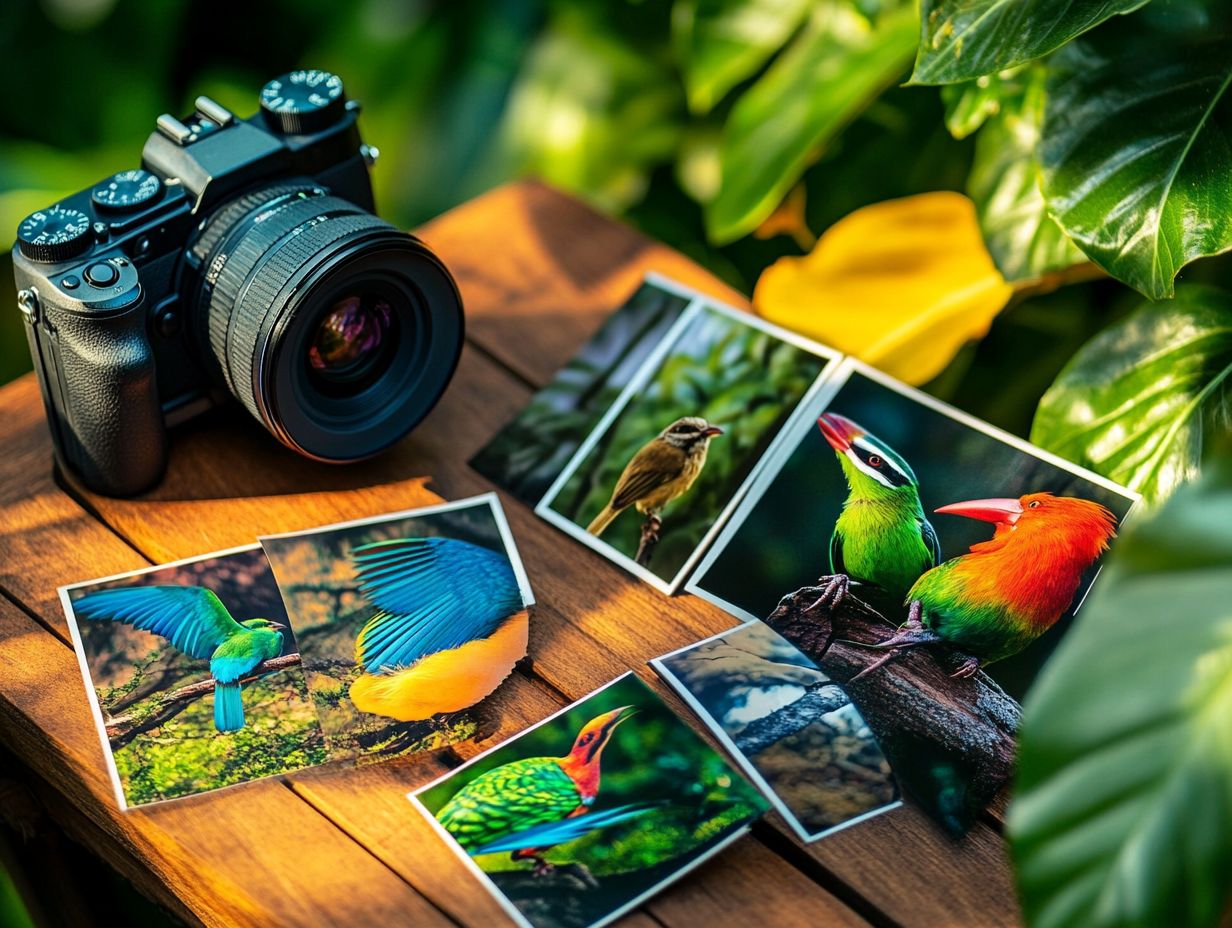
- Choose a variety of bird species to photograph, including common and rare birds, to add diversity to your varied portfolio.
- Invest in quality camera gear and understand recommended camera settings for bird photography, such as shutter speeds and aperture (the opening that controls light entry).
- Focus on composition and lighting techniques to create stunning bird photos, such as using the rule of thirds and shooting during the golden hour.
What is a Bird Photography Portfolio?
A bird photography portfolio is your curated collection that showcases stunning examples of your work, highlighting the beauty and diversity of bird species. To create captivating images, consider preparing for a bird photography outing. This portfolio stands as a testament to your skills and artistic vision.
By carefully selecting images that reflect your unique style, you engage your audience and share your journey through the captivating realm of wildlife photography.
An online portfolio serves as your digital gateway, inviting enthusiasts and potential clients alike to explore your expertise in various photography techniques. It s not just about the breathtaking images; it s also a chance to share insights into your creative process and the stories behind each shot.
This visual narrative encourages viewers to connect more deeply with the intricate details of avian life that might otherwise remain unnoticed. Ultimately, a well-crafted portfolio allows you to establish your identity as a photographer while fostering greater awareness of wildlife conservation and the enchanting world of birdwatching.
Choosing Your Subject Matter
Selecting the right subject matter is a pivotal step in bird photography, as it profoundly influences the overall quality and emotional depth of your portfolio. By choosing local species that are easily accessible, you not only deepen your understanding of their habits and behaviors but also create a more authentic photographic experience.
By concentrating on wildlife encounters across diverse environments, you can capture striking images that showcase the unique characteristics of various bird species while utilizing close-up images.
Finding and Selecting Bird Species to Photograph
Finding and selecting bird species to photograph requires thorough research and keen observation of your local environment to understand animal behavior. Identifying unique traits of various species enhances your field experience and enables you to capture action shots that truly resonate with your audience.
To immerse yourself deeper into this captivating world, consider leveraging local resources such as birdwatching clubs, field guides, and online communities that share valuable insights about specific habitats. Skills to observe wildlife without disturbing them, like stealthy movements and heightened situational awareness, will significantly increase your chances of witnessing exciting sightings.
Studying animal behavior, from feeding patterns to mating rituals, enriches your understanding and informs the perfect timing and settings needed for those impeccable shots.
By observing how different species interact with their surroundings, you can create authentic captures that tell compelling stories, enriching your portfolio while fostering a greater appreciation for the wonders of wildlife photography. Which local birds will you photograph today?
Equipment and Settings for Bird Photography
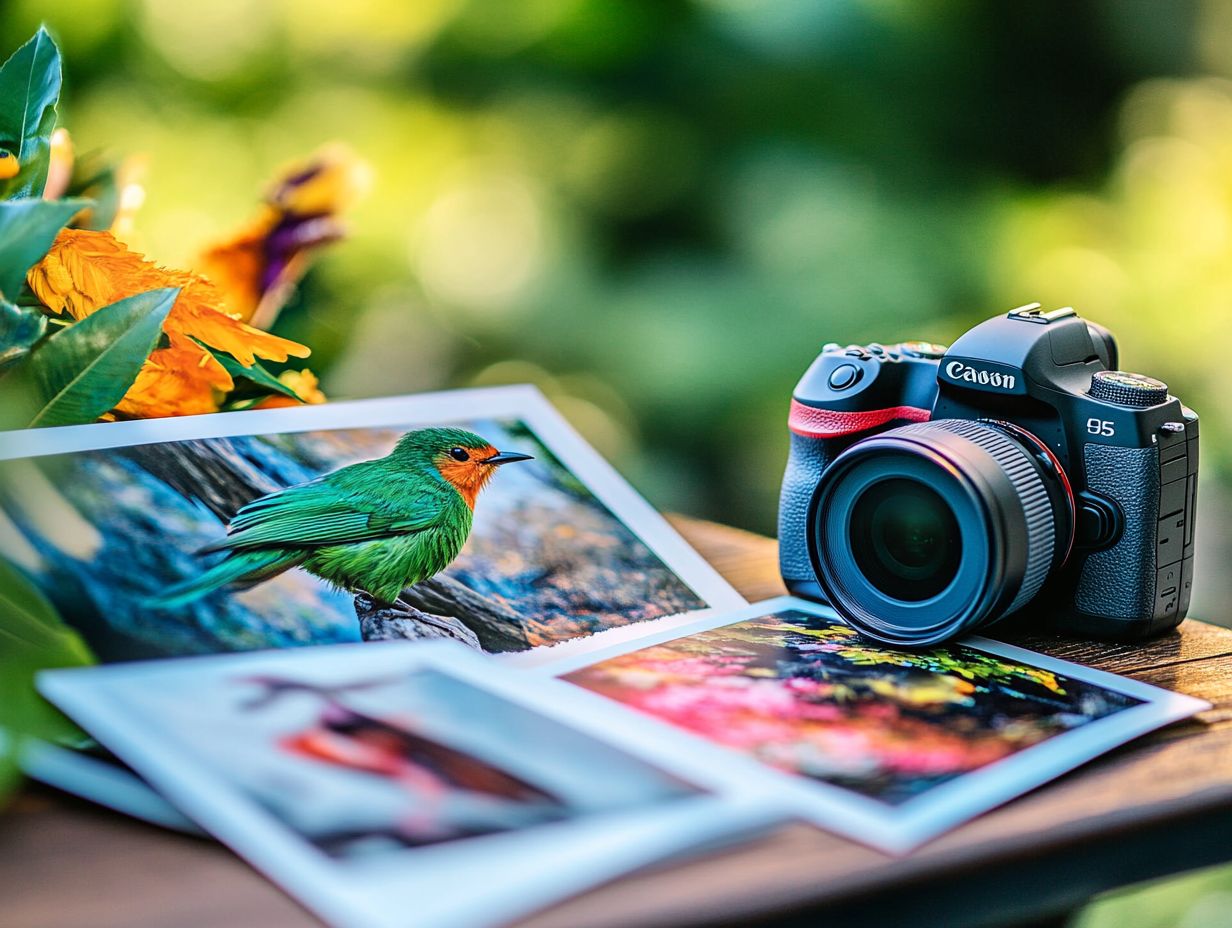
Having the right equipment and settings is crucial for achieving stunning bird photography. This affects your ability to capture fleeting moments while spending valuable time in the field.
Investing in high-quality camera gear, including fast lenses and dependable remote triggers, can elevate your ability to capture wildlife in action. It will enhance your photographic process.
Moreover, mastering camera settings like shutter speed and aperture is essential. Aperture controls the amount of light entering your camera, and these settings are vital for producing sharp, detailed images that shine in natural light, reflecting the essence of avian behavior.
Camera Gear and Recommended Settings
Selecting the right camera gear and settings can truly transform the quality of your bird photography. To create diverse compositions and captivating images, it s essential to utilize lenses with fast autofocus capabilities.
By mastering your camera settings for various lighting conditions, you ll be able to produce stunning wildlife images, even in the trickiest environments. For optimal results, consider investing in telephoto lenses that are between 300mm and 600mm. These lenses allow you to get close-up shots without disturbing the birds.
A sturdy tripod or monopod is crucial for stabilizing your camera during long shooting sessions, especially as the light begins to fade. Enhancing your toolkit with accessories like lens filters and remote shutter releases will significantly improve your ability to shoot in varying environmental conditions.
When bright sunlight is your challenge, remember to use faster shutter speeds and lower ISO settings to steer clear of overexposure. On the other hand, during overcast days or at dawn and dusk, feel free to lower your shutter speed and increase the ISO to maintain image clarity while adapting your approach to capture the essence of avian behavior and the enchanting light.
Composition and Lighting Techniques
Understanding composition techniques and lighting techniques is essential for creating visually captivating bird photographs that truly resonate with viewers.
By applying effective composition strategies such as the rule of thirds and leading lines you can craft dynamic images that command attention and showcase your subjects beautifully.
Moreover, harnessing natural light is essential to elevating your photographs’ quality. This enables you to capture stunning environmental shots and intimate close-ups that encapsulate the essence of your wildlife encounters while conveying emotions.
Tips for Capturing Stunning Bird Photos
Capturing stunning bird photos is an art that demands a harmonious blend of technical skills, patience, and a keen understanding of wildlife interactions. Don t wait! The perfect shot could be just around the corner.
By employing photography tips such as maintaining a low profile to avoid startling birds and utilizing burst mode to seize their movements, you can create evocative images that narrate the story of the species you re photographing.
These strategies not only elevate the quality of your images but also enrich your overall portfolio-building experience, making it essential for passionate photography.
Familiarizing yourself with the bird’s behaviors is vital. This knowledge enables you to anticipate their movements and positions, making it much easier to snag that perfect shot.
Harnessing natural light effectively, particularly during the enchanting hours of early morning or late afternoon, can infuse your images with warmth and enhance the overall mood, showcasing your understanding of the environment.
Investing in a high-quality zoom lens also equips you with the ability to frame your subjects beautifully from a distance, allowing you to explore different perspectives.
Above all, taking the time to observe these creatures in their natural habitat not only deepens your appreciation for wildlife but also hones the skills necessary for creating truly memorable photography that reflects your passion.
Organizing and Curating Your Portfolio
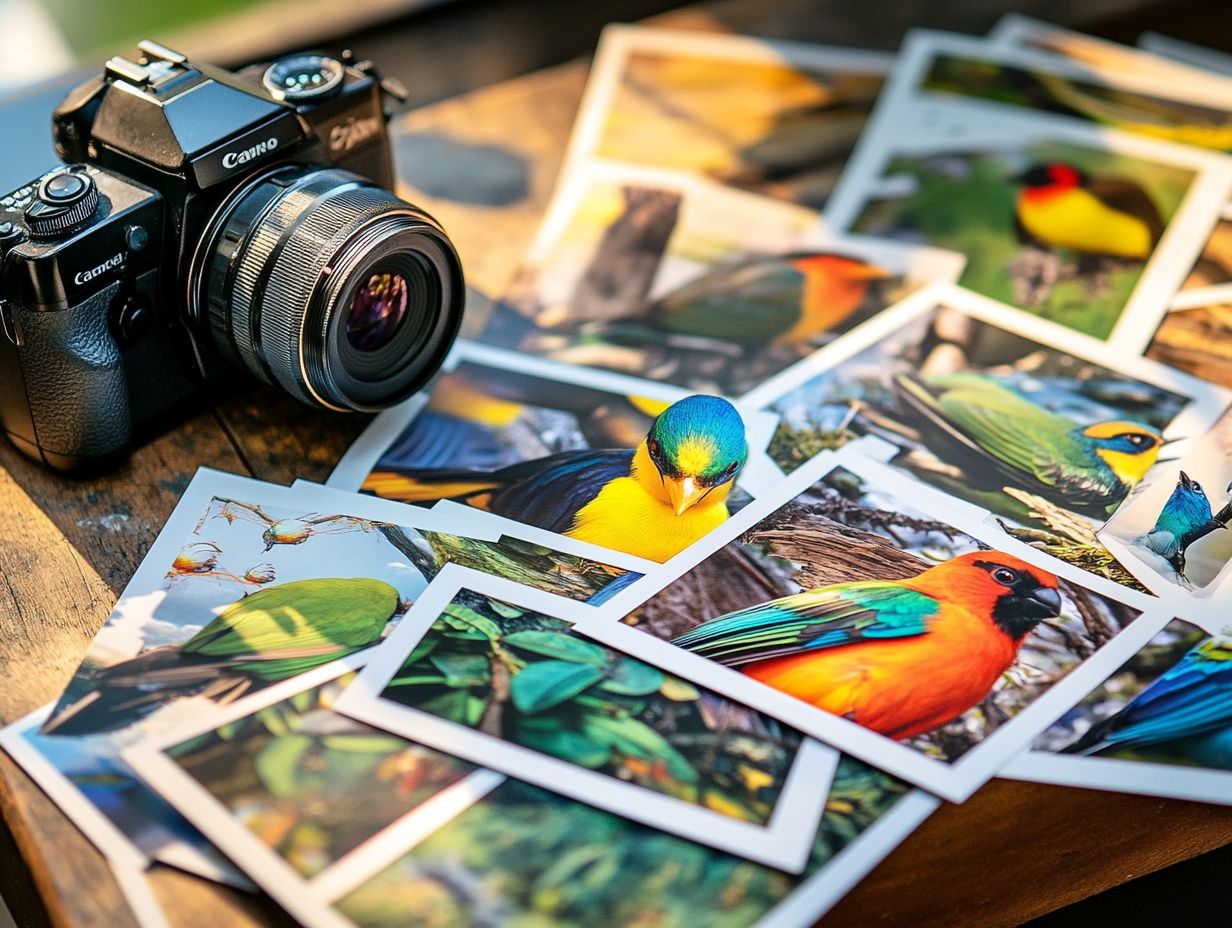
Organizing and curating your bird photography portfolio is vital for presenting your work in a cohesive and impactful way. To enhance your skills, consider checking out how to get started with bird photography. Select and arrange your images thoughtfully to grab attention and craft a diverse portfolio that showcases your expertise in wildlife photography while emphasizing your storytelling capabilities.
This approach elevates the viewer’s experience and effectively conveys your personal journey and passion for capturing bird species through ethical photography in their natural habitats.
Creating a Cohesive and Engaging Portfolio
Creating a cohesive and engaging portfolio is essential for showcasing your bird photography in a way that truly reflects your style, dedication, and expertise. To enhance your skills, consider exploring how to create stunning bird portraits. Focus on visual storytelling to draw viewers into your experiences and evoke emotions through your captivating images.
A thoughtfully arranged collection enhances your portfolio’s appeal and demonstrates your deep understanding of wildlife species and their environments.
To achieve this, consider organizing your portfolio by theme, grouping images by habitat, behavior, or seasonal changes. This approach provides context and weaves a narrative that captivates your audience.
Incorporating diverse photography styles like close-ups, wide shots, and action sequences adds depth and interest, showcasing your versatility. Maintaining consistent editing techniques ensures a uniform aesthetic that reinforces your brand identity.
By blending these elements, you elevate the overall impact of your portfolio, making it memorable and engaging for viewers. This invitation to appreciate the beauty of bird life is a testament to your skill and passion.
Promoting Your Bird Photography Portfolio
Promoting your bird photography portfolio is just as critical as creating it. Greater exposure can unlock opportunities for audience engagement and professional growth.
Leverage social media platforms to share your stunning work and connect with fellow enthusiasts, expanding your reach to a wider audience. Engaging in photography workshops and events provides valuable networking opportunities, enhancing your portfolio s visibility and elevating your presence in the community.
Sharing and Marketing Your Work
Sharing and marketing your bird photography work effectively can dramatically enhance your visibility and open doors within the photography community. Showcase your portfolio on platforms like Instagram and your personal website to cultivate a dedicated following and engage with an audience that shares your passion for wildlife photography.
Implement savvy marketing strategies, such as collaborations and promotions, to further expand your reach.
Utilizing relevant hashtags boosts your discoverability, while actively participating in online communities helps you forge meaningful connections. Regularly share content think behind-the-scenes shots and compelling narratives to captivate your audience and keep them coming back for more.
Entering photography contests or challenges provides valuable exposure and validates your creative efforts. Consider sending out email newsletters to keep your followers informed about exhibitions or new projects, complementing your online presence with tangible offline networking.
Collectively, these strategies enhance your impact, build your credibility, and lead to exciting photography opportunities. Start organizing your portfolio today to stand out in the photography community!
Frequently Asked Questions
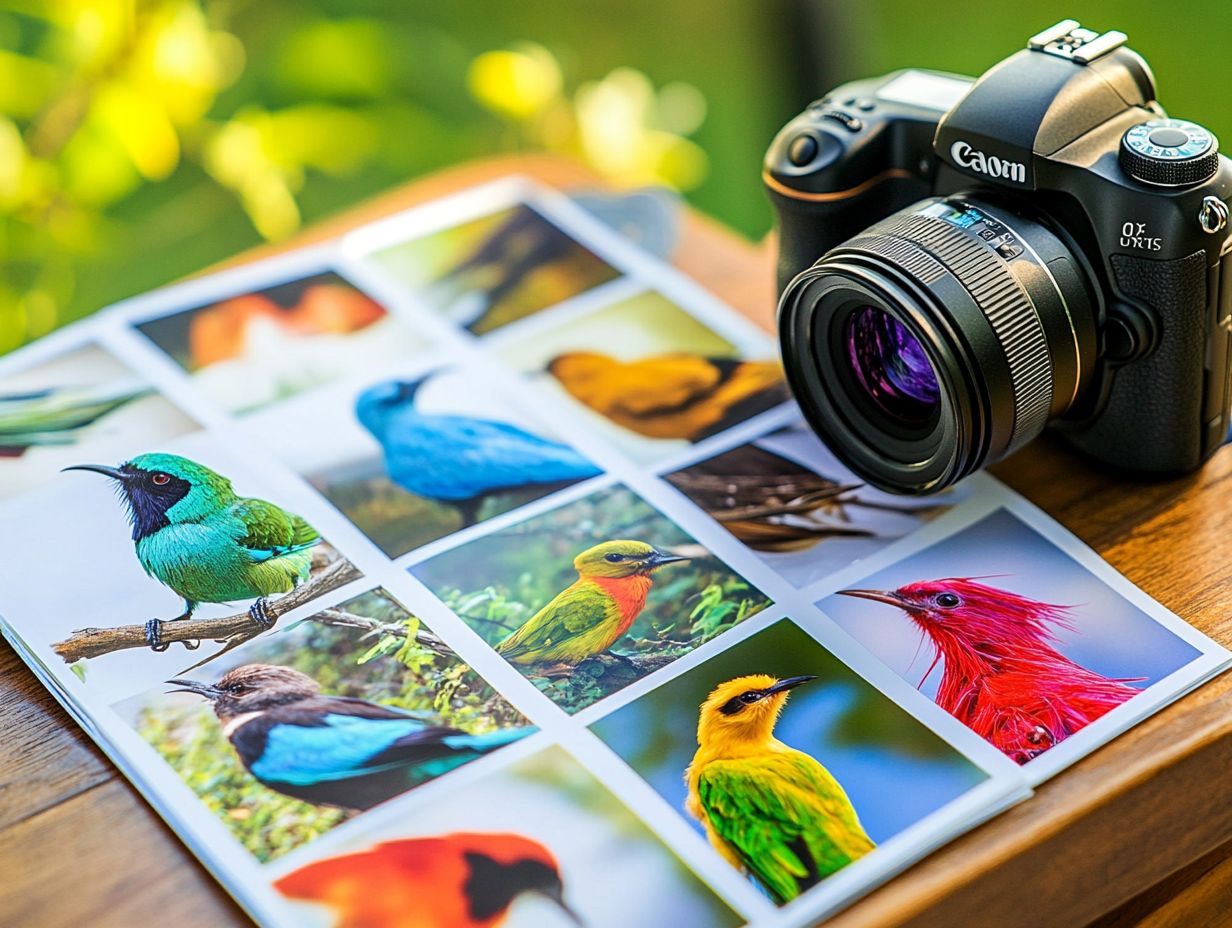
What is a bird photography portfolio?
A bird photography portfolio is a collection of your best bird photographs that showcases your skills and style as a photographer, including an understanding of the basics of bird photography composition.
Why should I create a bird photography portfolio?
Having a portfolio is important for any photographer as it serves as a visual representation of your work and can help attract potential clients or opportunities.
What are the key elements of a successful bird photography portfolio?
To create a successful bird photography portfolio, focus on a clear style and a variety of bird species. For more insights, check out Field Notes on bird photography. High-quality images and an organized layout are essential!
How many images should I include in my bird photography portfolio?
It’s recommended to include around 20-30 of your best images. Remember, quality is more important than quantity!
Do I need a website to showcase my bird photography portfolio?
A website helps you look professional. You can also create a physical portfolio or use social media to share your work!
What are some tips for a visually appealing bird photography portfolio?
Keep your layout clean and simple. Use thoughtful image placement and a cohesive color scheme!
Don t forget captions! They provide context and show off your knowledge.

